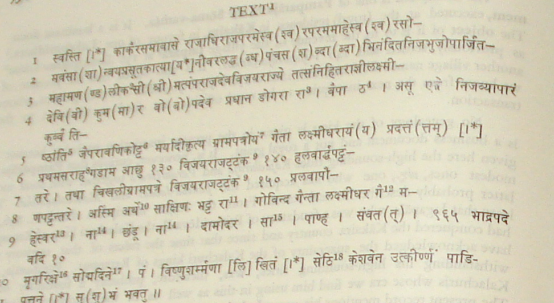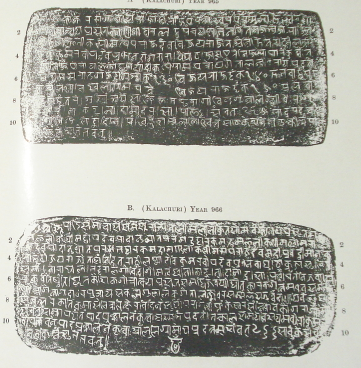|
MISCELLANEOUS INSCRIPTIONS

TRANSLATION
Hail! At the residence in Kākaira during the victorious reign of the Rājādhirāja,
paramēśvara (and) Paramamāhēśvara, the illustrious Pamparājadēva, (who is) born in
the Sōma-vaṁśa (lunar race), who is hailed as having obtained the five sounds by the boon
of (the goddess) Kātyāyanī and who has obtained (the title of) Mahāmāṇḍalika by (the strength
of) his own arm, while (there are) the queen Lakshmīdēvī (and) the prince Bōpadēva with
him, and the (officers such are) the Minister Dōgarā, Ṛāṇaka Vaipā and Ṭhakkura Asū are
present on duty, this village document (fixing the revenue of) Jāiparā, the traders’ fortress,¹⁹
is given to Gaitā Lakshmīdhara. (The amount fixed is) 130 āchhus of Sarāhagaḍa (as settled)
___________________
1 From ink impressions.
2 Read -महामाण्डलिक-.
3 I.e., Rāṇaka.
4 Hiralal ingeniously explained these five letters as abbreviations of Rāṇaka (chief councillor),
Rājamallabha (court-favourite), Vēśrika (chamberlain), Pārśvika (aide-de-camp) and Ṭhakkura (lord-in
waiting). According to him, these together with the minister, the village priest who is a party to the
present transaction, and the Raj Paṇḍit who wrote the present record, make the eight ministers
mentioned here. This explanation does not, appear to be correct. As the next inscription
(No. 117) shows, Asū (not asṭa) was the name of an official as indicated by Ṭhākṛi (i.e. Ṭhākura)
prefixed to it. There is, therefore, no clear reference to eight minister here.
5 Read कुर्व्वन्तस्तिष्ठन्ति.
6 Read वणिक्कोट्टं.
7 Read ग्रामपत्रमिदं.
8 The akshara ग, which was at first incised after ग, has been cancelled. Hiralal read सराहगजभाम.
9 Read -टंक- Hiralal suggested the reading विजयराज्यटंक.
10 Read अस्मित्रर्ये.
11 I. e., राणक.
12 I. e.,गैताor गैन्ता which still means the village-priest in the former Kāṅkēr and Bastar States.
13 Read , महेश्वर.
14 I. e., नायक
15 I. e., सावु.
16 Read मृगॠक्षे or मृगर्क्षे.
17 Read सोमदिने See above, p. 597, n. 5.
18 Read श्रेष्ठि-
19 See above, p. 597, n. 2.
|
CORPUS INSCRIPTIONUM INDICARUM
VOL IV.
PLATE XCVI.
TAHANKAPAR PLATES OF PAMPARAJADEVA :
A (KALACHURI) YEAR 965

|
|
Home
Page |